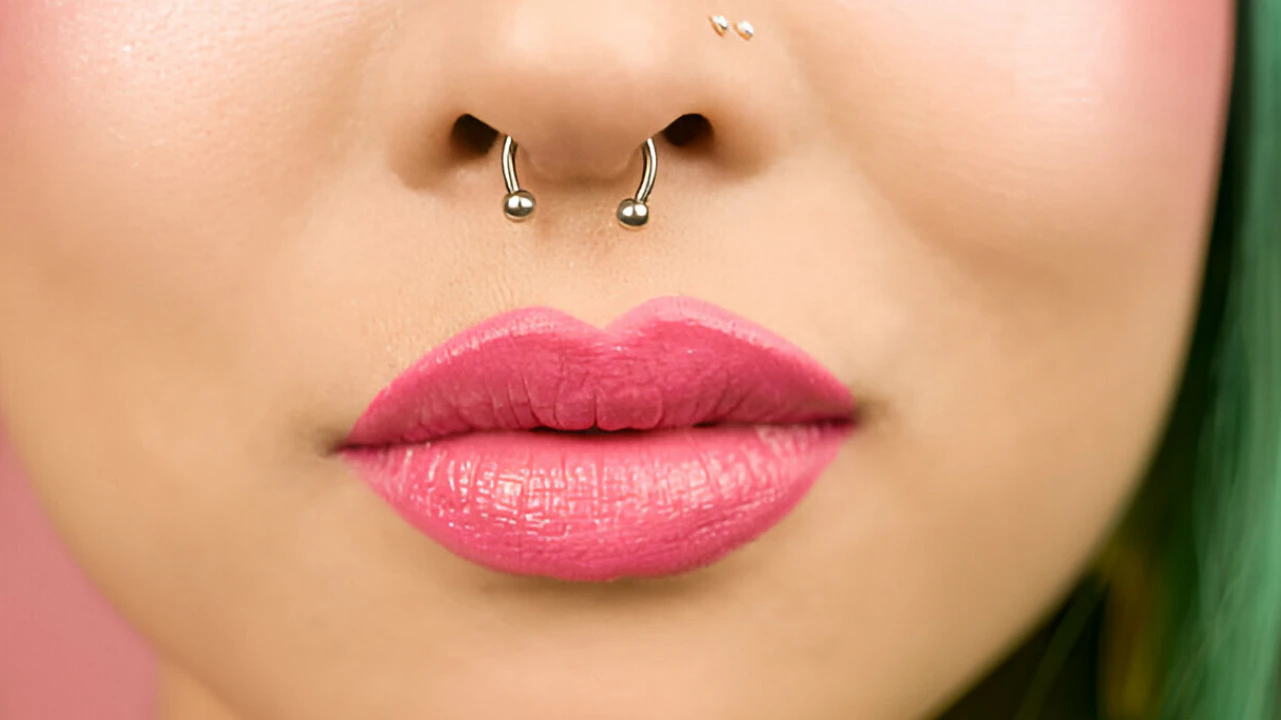Have You Been Thinking About Getting a Medusa Piercing?
Have you ever caught a glimpse of someone with a gorgeous little stud just above their upper lip and thought, “Wow, that looks so cool… I kinda want one”? If that’s you — welcome. You’re definitely not alone.
Medusa piercings are one of those facial piercings that quietly (but confidently) say, “I know who I am.” They’re not over-the-top or edgy in an in-your-face kind of way, but they’ve got a certain elegance — the kind of look that makes people want to ask questions, or at least admire from afar.
But let’s be honest. Piercings — especially facial ones — aren’t something you just wake up and get on a whim. It’s normal (and smart) to want to know how much it hurts, how long it takes to heal, what could go wrong, and whether it’s worth it. Trust me, doing a little research now can save you from a lot of regret later.
So that’s what this article is for. Think of it like a chat with your slightly-more-obsessed friend who’s already gone down the piercing rabbit hole and wants to make sure you have all the real info. I’ll break it all down: the pain, the healing process, the good stuff, and yes — the not-so-fun risks too. Because choosing to modify your body (even in small ways) deserves your full attention.
Whether you’re seriously planning to get one or just flirting with the idea, I’ve got your back. Let’s explore everything you should know about the Medusa piercing, so you can decide if it’s truly the right vibe for you. 💫
What Exactly Is a Medusa Piercing?

Where Is It Placed?
The Medusa piercing is placed right in the philtrum — that little vertical groove between your upper lip and your nose. It’s super central, which gives it a lot of visual symmetry and makes it one of the most striking piercings you can get.
People sometimes confuse it with a Monroe or a Madonna piercing, which sit off to one side. But the Medusa? Dead center. It’s like the middle child of upper lip piercings — balanced, stylish, and maybe a little underappreciated (but not for long).
When you get a Medusa piercing, your piercer will usually insert a flat-back labret stud through the tissue of the philtrum. And while it might sound a bit intense at first, a skilled professional makes the process quick and relatively straightforward.
What Does It Look Like?
Short version? It’s stunning. Long version? Totally depends on your vibe.
Some folks keep it simple with a sleek stainless steel ball or a flat disc — think low-key and effortlessly cool. Others like a bit more flair: a sparkly gem, a delicate gold stud, or a bright pop of color to really make the piercing stand out.
Because the Medusa sits right in the center above your lip, it draws attention to your lips and nose, subtly sharpening your whole facial look. It’s especially striking when paired with bold brows, a winged liner, or even a strong lipstick. Into makeup? This piercing can seriously level up your whole aesthetic (in the best kind of way).
Why Do People Choose It?
Everyone’s got their own reason for going Medusa. For some, it’s purely about the look — they just love the style. For others, it’s more personal — a way to express themselves without saying a word.
There’s something undeniably empowering about choosing to wear something so bold on your face. It’s a statement: “This is me, and I get to decide how I show up in the world.”
Some even connect it to something deeper. The philtrum — that little groove above your lip — ties into speech and self-expression. So for some, this piercing marks reclaiming their voice, owning their identity, or moving through a personal shift. (Or hey, maybe you just think it looks awesome — and that’s reason enough.)
Whatever your reason, just know this: if you’ve been thinking about a Medusa piercing for a while, it’s not random. There’s something in it that resonates with you. And that’s worth exploring.
How Painful Is a Medusa Piercing?
Pain Level Compared to Other Facial Piercings
Let’s talk about the big question everyone secretly wants to ask but sometimes feels awkward saying out loud: “Does it hurt?”
Short answer? Yes — but probably not as bad as you think.
Here’s the deal: pain is super personal. What feels like a 3 out of 10 for one person could feel like a full-blown 8 for someone else. But if we’re talking averages, most people describe the pain of a Medusa piercing as sharp and quick — like a pinch that makes your eyes water, followed by a dull throbbing that fades pretty fast.
Compared to other facial piercings, the Medusa tends to be somewhere in the middle. It’s generally considered more painful than an earlobe but less painful than a septum. Think of it as the “respectable spicy” on the piercing pain scale — not mild, not extreme, just… notable.
Real Stories: What People Say It Feels Like
Let me share a few things people have said (including yours truly):
- “It was over so fast, I barely had time to react. The clamp was more uncomfortable than the needle.”
- “It hurt for a few seconds and then just felt like pressure. I’ve had eyebrow piercings that stung worse.”
- “My eyes teared up instantly, but not from the pain — it’s just a reflex.”
Most piercers will tell you the procedure itself takes under 10 seconds. So if you’re psyching yourself out, remember: you’ve probably had paper cuts that lingered longer.
Pro Tip: Breathe Through It
No joke — don’t forget to breathe. Staying calm and keeping your breathing steady can really help take the edge off. It makes the whole thing feel way less overwhelming. Some folks bring a friend for support, others pop in earbuds and zone out to their favorite playlist. Whatever helps you chill, go for it.
Does the Pain Mean It’s a Bad Idea?
Not even close. Pain’s just part of the deal, and it usually passes pretty quick. But if you’re extra sensitive or get anxious about needles, that’s totally valid. Just be upfront about it. A solid piercer will explain everything, check in with you, and make sure it’s all at your pace — no pressure.
Also, who’s doing the piercing matters big time. A skilled pro can make the process quicker and smoother. So yeah — always go with someone who knows their stuff and comes highly recommended.
And let’s be real — you’re getting a needle through your face. That’s hardcore. Whether it stings or not, give yourself some props just for going through with it. That’s bold. 💪
Healing Process & Aftercare

How Long Does a Medusa Piercing Take to Heal?
So you did it — you faced the needle, checked yourself out in the mirror (maybe a few too many times — we’ve all been there), and now you’re wondering how long it’s gonna take to heal.
Generally, it takes about 6 to 12 weeks for the outer part to heal — so it might feel fine sooner than you think. But don’t get too comfy! Deep healing can take up to 4 to 6 months, depending on your body, your routine, and how well you stick to aftercare.
Healing isn’t a straight line either. Some days, it’ll feel perfect. Other days? It might swell a bit, get tender, or look slightly irritated. That’s normal — as long as you’re not seeing signs of infection (we’ll get into that shortly), you’re doing fine.
Essential Aftercare Tips for a Smooth Recovery
Taking care of your Medusa piercing is kinda like adopting a new pet — it needs regular attention, gentle love, and zero neglect. Here’s what your aftercare routine should look like:
Step-by-Step Daily Care Routine
- Clean it twice a day with saline solution. You can make your own by dissolving 1/4 teaspoon of sea salt in 1 cup of warm distilled water.
- Use a cotton swab or clean gauze pad — never your fingers — to gently dab around the area. Be patient and avoid over-scrubbing.
- Rinse your mouth with alcohol-free mouthwash after eating or drinking anything other than water. Your mouth is full of bacteria, and we want none of it interfering with your new bling.
- Wash your hands before even thinking about touching your piercing. Honestly, just pretend it’s a little sacred altar that only deserves clean, respectful handling.
What to Avoid During Healing
There are a few habits and lifestyle things that can mess with your Medusa’s healing — and some of them might surprise you:
- No smoking or vaping. These can irritate the tissue and delay healing.
- Cut back on spicy and acidic foods (like citrus or vinegar) in the early days. They can sting and cause inflammation.
- Don’t play with it — even if it’s tempting. Twisting, spinning, or pulling the jewelry can cause micro-tears and prolong healing (not to mention raise your risk of infection).
- Avoid makeup, creams, and balms around the piercing site. Your skincare routine might need a little adjustment while things settle down.
Watch for These Signs
It’s important to know the difference between normal healing and something that might need attention. Redness, slight swelling, and clear discharge? Totally normal. But if you notice:
- Thick yellow or green pus
- Intense pain that doesn’t go away
- Swelling that seems to be getting worse
- A hot, throbbing sensation
…then it’s time to reach out to your piercer or a healthcare provider. Better safe than sorry, always.
Need a more in-depth reference for piercing safety? This guide from Association of Professional Piercers is a great resource — check it out and bookmark it for later.
And remember: healing is your body’s way of saying “I got you.” So return the favor by being kind to it. The effort you put in now will pay off with a stunning, trouble-free piercing later.
What Are the Risks of a Medusa Piercing?

Common Risks and How to Minimize Them
Okay, deep breath — it’s time to talk about the not-so-glamorous side of things. Like any body modification, a Medusa piercing does come with a few risks. But before you start picturing worst-case scenarios, know this: most issues can be avoided or easily handled with proper care.
Here are a few common concerns, and what you can do to stay on top of them:
- Infection: Easily the most common risk. It usually happens from touching the piercing with dirty hands, improper cleaning, or introducing bacteria (like kissing too soon or not rinsing after eating). Keep it clean, and you’ll keep it safe.
- Swelling: Some swelling is completely normal for the first few days. But if your lip starts looking like a balloon or you’re in serious discomfort, that’s a sign to check in with your piercer.
- Irritation bumps: These can pop up if your jewelry is too tight, the metal’s irritating your skin, or you’re over-cleaning. Don’t panic — they’re usually treatable with gentler care and a quick adjustment from your piercer.
Long-Term Considerations: Gum Erosion and Tooth Damage
This part doesn’t get talked about enough, so let’s bring it into the light. A Medusa piercing sits very close to your gums and teeth — and over time, it can cause issues if you’re not careful about the jewelry you choose or how it fits.
Here’s what to watch out for:
- Gum recession: If your jewelry rubs constantly against your upper gums, it can slowly cause them to recede. This doesn’t happen to everyone, but it’s something to keep an eye on — especially if you start to notice sensitivity or visible changes in your gumline.
- Tooth enamel wear: Similarly, if the back of your jewelry presses against your teeth, it can wear down enamel over time. Not great, right?
The fix? Well-sized, high-quality jewelry. Your piercer should help you choose a longer bar initially (to accommodate swelling) and then downsize it after a few weeks to minimize friction. This step is crucial — don’t skip it!
Can It Leave a Scar?
Yes, it can — especially if you remove it too soon, have complications, or frequently play with it. Like any piercing, the Medusa can leave a small scar or mark when taken out, particularly if it was stretched or had issues during healing.
That said, for many people, the scar is minimal and fades over time. If you’re worried about long-term aesthetics, talk to your piercer about how to support healthy healing and what to do if you ever want to remove it.
Scar Care Tips (Just in Case)
If you ever take it out and are left with a mark, you can help the skin bounce back with:
- Vitamin E oil or silicone gel — promotes regeneration
- Sunscreen — yep, UV exposure darkens scars
- Gentle massage — increases blood flow to the area
But honestly? Most people find any residual marks to be tiny and barely noticeable — especially compared to the confidence they gained from rocking the piercing in the first place.
Just keep listening to your body, checking in with your piercer, and giving your piercing the care it deserves. Risks are real, but with the right approach, they’re absolutely manageable.
How Much Does a Medusa Piercing Cost?
Typical Price Range
Let’s talk numbers, because no one wants a surprise bill — especially when there’s a needle involved. 💸
The cost of a Medusa piercing can vary depending on where you live, the experience of your piercer, and the jewelry you choose. But generally speaking, you can expect to pay anywhere from $40 to $100 for the piercing itself.
Now, if that seems like a wide range, it’s because not all studios are created equal. A top-tier, licensed piercer in a major city might charge more, and honestly? They’re worth it. When it comes to something that’s going in your face — and near your teeth and gums — you really don’t want to cheap out.
What’s Included in the Price?
Let’s break it down so you know what you’re actually paying for:
- The piercing procedure: This includes setup, sterilization, and the piercer’s time and expertise. (It’s not just a poke — it’s a skill.)
- Initial jewelry: Most shops include a basic titanium or surgical steel stud in the price. Fancier pieces — like gold or custom gems — are extra.
- Aftercare guidance: Many piercers will give you a care sheet, and some include a starter saline spray or rinse kit.
Some studios even offer a free downsize appointment after the swelling goes down (usually within 2–4 weeks). This is super important — the initial jewelry is longer to accommodate swelling, but once everything settles, switching to a shorter bar helps prevent irritation and gum damage.
Is It Worth the Investment?
Totally! Think about it this way — you’re investing in a look that’s so you. It’s a tiny, powerful piece of self-expression that can change how you feel when you look in the mirror. That confidence? Priceless.
Just make sure you’re paying for quality. If someone’s offering a Medusa piercing for $20 in the back of a vape shop… run. Fast. A professional, hygienic setup isn’t just safer — it usually means a better experience and better results.
Pro tip: when comparing prices, don’t just ask “how much?” Ask what’s included, who’s doing the piercing, and what materials they use. You deserve transparency and care.
Choosing the Right Piercing Studio

What to Look for in a Professional Piercer
Choosing the right studio isn’t just about finding a place with cool vibes or neon lighting. This is your face — you want someone who knows exactly what they’re doing.
A professional piercer will prioritize your safety, comfort, and long-term satisfaction over everything else. Here’s what to look for when you’re browsing studios or booking a consultation:
- Licensing and certifications: Your piercer should be fully licensed and follow local health department regulations. Don’t be shy — it’s okay to ask!
- Clean, sterile environment: The studio should be spotless. Tools should be individually packaged and sterilized. If anything feels sketchy, trust your gut and walk away.
- Portfolio of past work: A great piercer will have photos of real clients — not just stock images. Look for healed results and symmetrical placements.
- Reputation: Read online reviews, and don’t underestimate the power of word-of-mouth. Happy, repeat clients are always a good sign.
If you’re not sure where to start, the Association of Professional Piercers has a searchable database of qualified piercers near you. It’s a great resource when you’re hunting for pros you can trust.
Questions to Ask Before You Commit
This might sound a little extra, but asking the right questions before your appointment can seriously help you feel more in control (and less nervous). A good piercer will happily answer all of the following:
- “What’s your experience with Medusa piercings?”
- “What type of jewelry do you recommend for initial healing?”
- “How do you handle swelling and downsizing?”
- “What’s your aftercare advice, and do you offer follow-ups?”
Suggested Checklist
Still not sure you’ve found the right place? Here’s a quick mental checklist you can run through before you say yes:
- ✅ They explain the procedure clearly
- ✅ They talk you through the risks without brushing them off
- ✅ They give you space to ask questions — and actually listen
- ✅ You don’t feel rushed or pressured
- ✅ The studio looks, smells, and feels clean and professional
Bottom line? You deserve to feel safe, seen, and respected. Getting a Medusa piercing should be exciting — not stressful. So take your time, do your homework, and go where your gut feels good. 🖤
What If You Change Your Mind Later?
Can It Be Removed Easily?
Here’s a truth that doesn’t get enough love: it’s 100% okay to change your mind.
Maybe you loved your Medusa piercing for a year but feel like you’re in a different season of life now. Or maybe you tried it out, and it just didn’t feel like “you.” Whatever the reason — yes, it can be removed.
Taking out a Medusa piercing is usually quick and simple. You can either do it yourself (carefully and cleanly) or have your piercer remove it for you. Just make sure to clean the area afterward and keep it free from bacteria while the hole starts to close up.
What Will Happen to the Scar or Skin?
Most of the time, once the jewelry is out, your body will start closing the hole on its own. For some, this happens in just a few weeks. For others, it might take a bit longer — and yes, some scarring is possible.
But here’s the good news: most Medusa scars are small, flat, and pretty discreet. Unless there were complications during healing (like a bad infection or repeated trauma), it’s unlikely to leave a mark that really stands out.
If you’re worried about how it’ll look afterward, there are ways to help the skin bounce back:
- Hydration: Keep the area moisturized with a skin-safe oil or balm.
- Scar treatments: Silicone scar sheets, rosehip oil, and vitamin E can all help fade marks over time.
- Sun protection: This one’s huge. Scars can darken under the sun, so use SPF even on cloudy days.
Healing After Removal
Once the piercing is out, it’s important to treat your skin with the same care you gave it during healing. No picking, no harsh scrubs — just gentle TLC and patience. Your body knows what to do; you just need to support it.
And if you ever decide you want it back? You can usually get it re-pierced in the same spot — as long as the tissue is healthy and fully healed. Talk to your piercer to see if a re-do is right for you.
So yes, getting a Medusa piercing is a commitment — but it’s not a life sentence. You’ve got options, always. 💖
Final Thoughts on Medusa Piercings
So — here we are. We’ve covered the sparkle and the sting, the care and the caution, the real-life risks and the totally-worth-it rewards. And honestly? You’ve done your homework. That’s something to feel good about.
A Medusa piercing is more than just a tiny stud above your lip. It’s a choice. A moment of expression. A little spark of rebellion or elegance or mystery — depending on what you make it. Whether you’re doing it for the vibe, the symbolism, or just because it feels like “you,” the key is going in informed, prepared, and empowered.
It might hurt a little. It might swell more than you expected. You’ll have to clean it. You’ll have to be patient. But you’ll also catch yourself in the mirror one day and think, “Wow. That’s me. And I look amazing.”
If you’re still unsure, take your time. There’s no rush. Ask questions. Talk to professionals. Trust your instincts. And if you do go for it? I’m cheering for you the whole way. 💫
Have you had a Medusa piercing before? Thinking about getting one soon? I’d love to hear your story, your worries, your excitement — whatever’s on your mind. Drop a comment or share your experience. Let’s make this a space where we can all learn, connect, and maybe even inspire someone else to take the leap.
You got this. 💖


















Leave a Reply
You must be logged in to post a comment.